Advancing Sustainability of Process Industries through Digital and Circular Water Use Innovations
Sustainable and robust water system for the industrial zone of Antwerp
Background and state of the art
The Port of Antwerp is the leading European oil and chemical cluster in Europe and home to key industrial players in chemicals production. Several of these chemical companies are large water users that require water for processing products, for cooling and for steam production. The freshwater source that connects to the Antwerp harbour is the Albert Canal. The Albert Canal on its turn takes its water from the river Meuse. Drinking water company Water-link abstracts water from the Albert Canal for drinking water production. Due to climate change, there is increasing salinization of the dock waters in the port, as well as of the River Scheldt and the Albert Canal. The available amount of freshwater is declining. Therefore, large water users in this region are obliged to investigate alternative water sources.
The largest water user in the port of Antwerp is the BASF site, which abstracts water from the docks for cooling purposes, water that contains a substantial concentration of salts. In case of climate change, the water quality of the harbor dock will change, and this will undoubtedly affect the management of cooling water in the system. BASF is also shifting towards a new demineralized water treatment using fresh surface water from the Biesbosch area based upon reverse osmosis (RO) technology. The concentrate from the RO will be highly loaded in terms of NaCl, very promising for possible reuse options. Additionally, BASF currently has a number of organically and salt loaded wastewaters which are currently not reused.
The area is, thus, facing increased problems of managing freshwater resources – for drinking water, industry and transport (inland shipping) – in terms of both water quantity and water quality. The stakeholders in the area need to develop strategies that ensure that water quality and scarcity are factored into decisions that protect current operations and support business growth. This requires the development of integrated water-smart strategies for industrial processes demonstrating water recycling technologies and real-time smart monitoring and management systems.
Actions and expected results
CS#3 is divided in two subcases with clearly different objectives:
CS#3-1 aims to develop real time smart monitoring and management information system for monitoring water quantity and quality to:
To achieve these goals, conductivity, temperature, and depth (CTD) sensors will be installed in the harbour docks and in the Albert Canal, to provide insights into the water and salt balances. Sensor measurements will be analyzed with operational conditions and data will be taken up in a modelling approach for the area, focused on the (operational) requirements of the stakeholders.
CS#3-2 has three main objectives for cooling water and water reuse:
To achieve these goals, conductivity, temperature, and depth (CTD) sensors will be installed in the harbour docks and in the Albert Canal, to provide insights into the water and salt balances. Sensor measurements will be analyzed with operational conditions and data will be taken up in a modelling approach for the area, focused on the (operational) requirements of the stakeholders.






